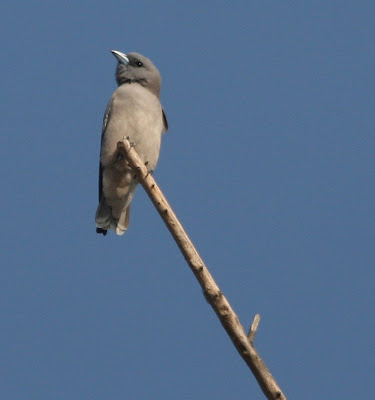Short-eared Owl, 10th
Showers overnight and a southerly airflow for the
8th - a second consecutive day of southerly winds being a rare occurrence so far this spring - brought modest returns, with visible migration evident but few grounded migrants; the highlight was a cream-crown
Marsh Harrier high and in off the sea, while other notables included high flying flocks of
corvids (mainly Carrion Crows),
Yellow Wags, a
Whimbrel and
Hirundine migration that
very much stole the show.
Another photo of another Wheatear - not why, but why not
Personal counts of 650
Swallows, 290
House Martins and 200
Sand Martins were doubtless a fraction of the true figures moving through in an impressive, constant flow, and the wire fence along the north cliff was often weighed down with dozens of birds taking brief rests; and as could be seen when scanning from higher ground, birds were moving along at least several different main flightlines. Hence, 'thousands' is probably the best (if somewhat downplaying) description of numbers.
A Cuckoo circumnavigating blissfully unaware tourists
The morning of the
9th was pleasantly mild and sunny with a light easterly, and a wander around the south side produced limited results, although a
Cuckoo along the cliff path and a
Garden Warbler singing at the bridge were both firsts for the year. Plenty of other common migrants were evident, with up to 50
Swifts and a good scattering of warblers - most notably
Common Whitethroats, seemingly occupying all available habitat. The afternoon became gradually cooler, cloudier and breezier (from the
east), but the best of several hours on the northern circuit were three
Common Sandpipers together on the rocks below Carr Naze.
Common Swift - uncommonly magical
And so to the
10th, a day of clashing weather systems and changing conditions; once again, the entertainment was incoming and overhead (as opposed to
in situ), and the sight of two fresh-in
Short-eared Owls instantly patrolling the cliff edge was a pleasure, especially when one promptly caught breakfast and then staged a close-up fly by for good measure.
Wren
Hirundines continued to plough through, with all three species reaching double figures again as well as other common migrants in small numbers (including six
Wheatears on the Naze - the majority at least being new birds based on plumage and sex). However, it took til early afternoon for the highlight of the day, which appeared low over the top scrub before disappearing over the cliff-edge - an
Osprey, the second of the spring, and always a thrill.
Osprey, 10th
So May thus far has been pretty hard work, with circumstances, in common with April, being far from advantageous; generally messy conditions, ascendant low pressure systems and a lack of any sustained southerly airflows has somewhat curtailed possibilities so far. Although, it being spring, there have been highlights on most days, and all it takes is a change in the weather for something special to happen.....
Barnacle Goose (belatedly), Filey Dams, 4th






















































